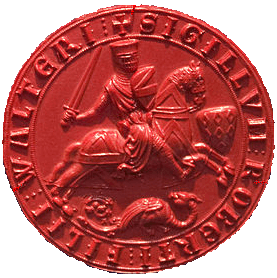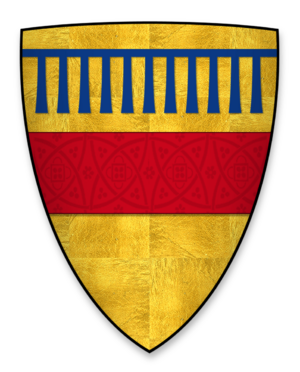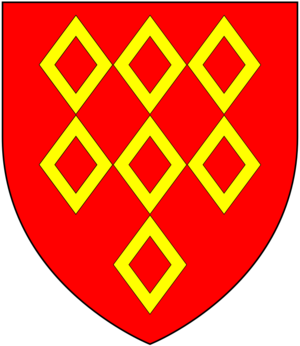Saer de Quincy, 1st Earl of Winchester facts for kids
Saer de Quincy, 1st Earl of Winchester (born around 1155, died November 3, 1219) was a very important person in both Scotland and England. He was one of the main leaders of a group of powerful nobles who rebelled against John, King of England. He played a big part in the history of his time.
Contents
Early Life in Scotland
Saer de Quincy's family came from Normandy, France. However, his father, Robert de Quincy, married a Scottish noblewoman named Orabilis. She was the heir to a large area called Leuchars. This meant Saer's father became a lord over lands in Fife, Perth, and Lothian in Scotland.
Saer grew up mostly in Scotland. He became important in England partly because he married Margaret. She was the younger sister of Robert de Beaumont, 4th Earl of Leicester, a very powerful earl. When Earl Robert died in 1204, Margaret became one of the two heirs to his huge earldom. The lands were divided, and after this was finalized in 1207, Saer de Quincy was given the title of Earl of Winchester.
Becoming the Earl of Winchester

After his marriage, Saer became a key military and diplomatic figure in England. He did not seem to be especially close to King John. His rise to power was likely due to his new high rank and his family connections.
Saer became very good friends with his cousin, Robert Fitzwalter. In 1203, they were in charge of the important fortress of Le Vaudreuil in Normandy. They surrendered the castle to Philip II of France without a fight. This made England's position in northern France much weaker. People at the time blamed them for giving up the castle. However, King John later said that he had ordered them to surrender. Both Saer and Fitzwalter had to pay large ransoms to the French.
Saer was more successful in Scotland. From 1211 to 1212, he led a large group of knights and soldiers. They helped King William the Lion fight against rebels called the Mac Williams. Some historians think this force might have been a group of hired soldiers from Brabant that King John had lent to William.
Magna Carta and Rebellion

In 1215, a rebellion of nobles began against King John. Robert Fitzwalter became the military leader. Saer de Quincy joined him. Saer was one of the main people who helped write the Magna Carta and negotiate with King John. Both cousins were among the 25 nobles who guaranteed that the Magna Carta would be followed.
After the Magna Carta was signed, problems continued. Saer fought against King John. He and Fitzwalter traveled to France to invite Prince Louis of France to become the new King of England. Saer and Fitzwalter were strong supporters of Louis. They supported him against both King John and later against the young King Henry III.
Journey to the Fifth Crusade
When the nobles were defeated, Henry III became king. Saer de Quincy then decided to go on a crusade. This was a religious journey, perhaps to fulfill a promise he had made earlier. In 1219, he left to join the Fifth Crusade. At that time, the crusaders were trying to capture a city called Damietta.
While he was in the East, Saer became sick and died. He was buried in Acre, which was the capital of the Kingdom of Jerusalem. His heart was brought back to England and buried at Garendon Abbey near Loughborough. This abbey was supported by his wife's family.
Saer de Quincy's Family History
The de Quincy family came to England after the Norman Conquest. They took their name from a place called Cuinchy in France. The name "Saer" was used by many men in the family over several generations. You might see their names spelled differently in old books, like Saher or Seer for the first name, and Quency or Quenci for the last name.
The first Saer de Quincy (called "Saer I" by historians) lived in the early 1100s. He was the lord of Long Buckby in Northamptonshire. He was the second husband of Matilda of St Liz. Matilda was the stepdaughter of King David I of Scotland. Saer I and Matilda had two sons, Saer II and Robert de Quincy. It was Robert, the younger son, who became the father of the Saer de Quincy who was the Earl of Winchester. Matilda was also the grandmother of Earl Saer's close friend, Robert Fitzwalter.
Robert de Quincy did not inherit any land in England from his father. He became a knight in Scotland. From about 1160, he was a close companion of his cousin, King William the Lion. By 1170, he married Orabilis, who was the heir to the Scottish lordship of Leuchars. Through her, he became lord of many lands in Scotland, including areas in Fife, Strathearn, and Lothian.
Saer de Quincy, the Earl of Winchester, was the son of Robert de Quincy and Orabilis. He grew up mostly in Scotland. Because he wasn't often mentioned in English records when he was young, some historians used to confuse him with his uncle, Saer II. Saer II took part in a rebellion in 1173, when the future Earl of Winchester was just a toddler. Saer II did not have children who survived, so his nephew, Saer de Quincy, eventually inherited his family's lands in England and possibly some in France.
Saer de Quincy's Children
Between 1188 and 1193, Saer de Quincy married Margaret, the youngest daughter of Robert de Beaumont, 3rd Earl of Leicester. Saer and Margaret had several children:
- Lora, who married Sir William de Valognes.
- Arabella, who married Sir Richard Harcourt.
- Robert (died 1217); he married Hawise of Chester, 1st Countess of Lincoln.
- Roger, who became the next Earl of Winchester after his father.
- Robert de Quincy (another son named Robert; died 1257), who married Elen, daughter of the Welsh prince Llywelyn the Great.
- Hawise, who married Hugh de Vere, 4th Earl of Oxford.
- Mary, who married Hugh le Despenser (sheriff).
- John de Quincy
- Saher de Quincy
| Peerage of England | ||
|---|---|---|
| New creation | Earl of Winchester 1207–1219 |
Succeeded by Roger de Quincy |
|


